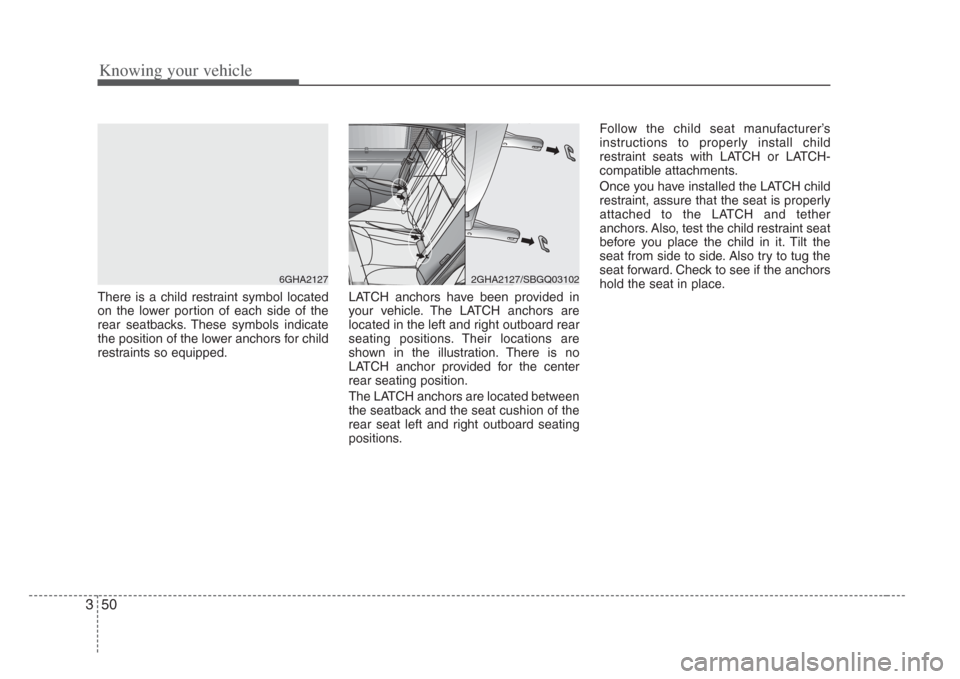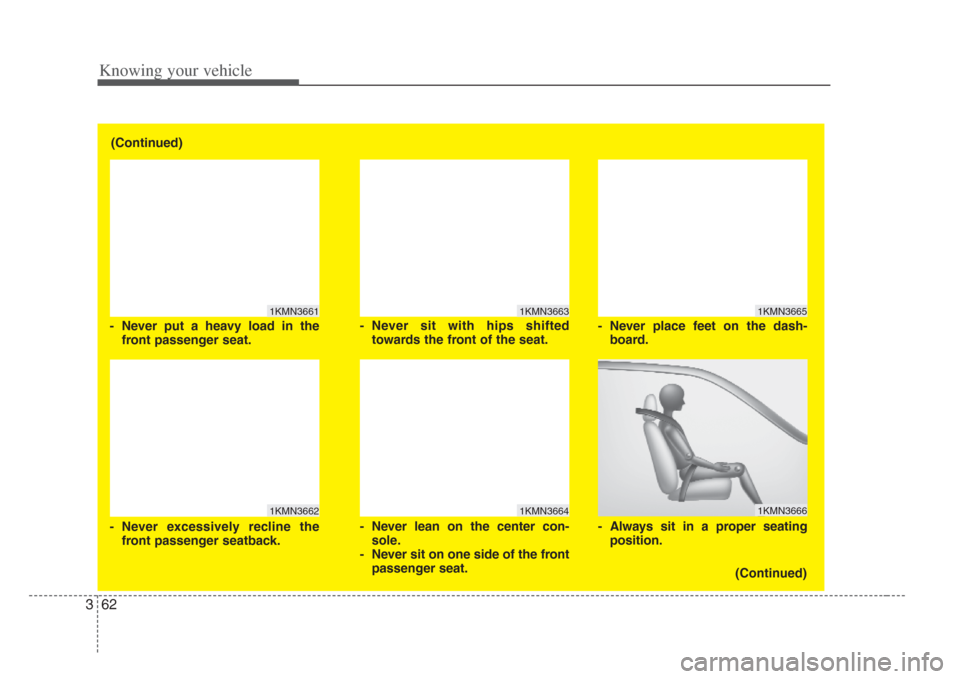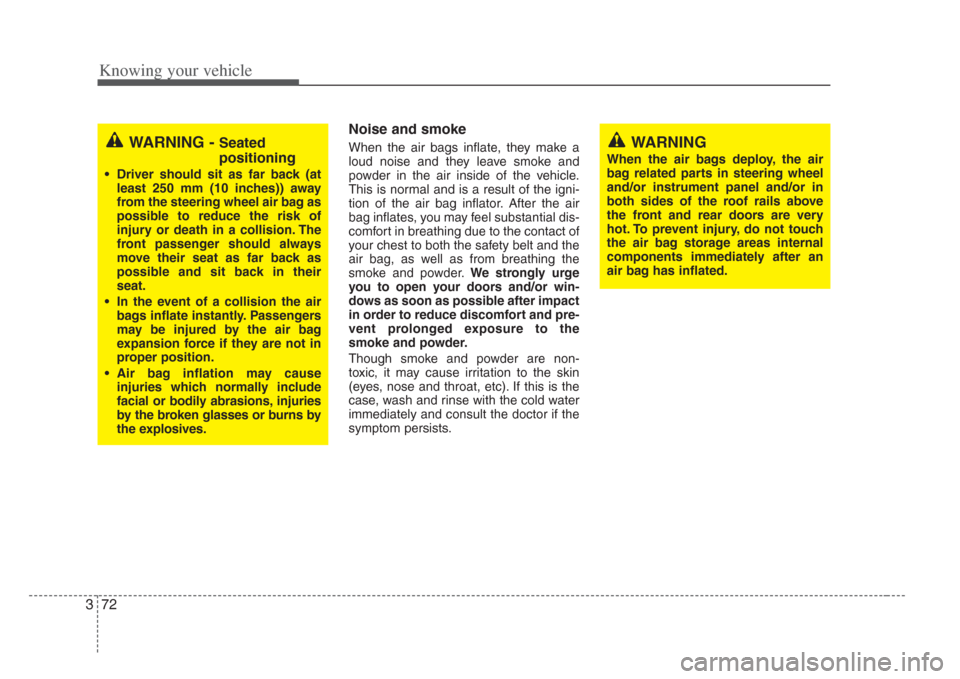2008 KIA Opirus Back seat
[x] Cancel search: Back seatPage 60 of 283

Knowing your vehicle
503
There is a child restraint symbol located
on the lower portion of each side of the
rear seatbacks. These symbols indicate
the position of the lower anchors for child
restraints so equipped.LATCH anchors have been provided in
your vehicle. The LATCH anchors are
located in the left and right outboard rear
seating positions. Their locations are
shown in the illustration. There is no
LATCH anchor provided for the center
rear seating position.
The LATCH anchors are located between
the seatback and the seat cushion of the
rear seat left and right outboard seating
positions.Follow the child seat manufacturer’s
instructions to properly install child
restraint seats with LATCH or LATCH-
compatible attachments.
Once you have installed the LATCH child
restraint, assure that the seat is properly
attached to the LATCH and tether
anchors. Also, test the child restraint seat
before you place the child in it. Tilt the
seat from side to side. Also try to tug the
seat forward. Check to see if the anchors
hold the seat in place.
6GHA21272GHA2127/SBGQ03102
Page 65 of 283

355
Knowing your vehicle
Air bag system components
• The SRS air bag consists of the fol-lowing components;
1. Driver's air bag module
2. Passenger's air bag module
3. Side air bag module
4. Curtain air bag module
5. Front impact sensors
6. Side impact sensors
7. SRS air bag control module
8. Driver's seat position sensor
9. Occupant Classification System (Front passenger's seat only)
10. "PASSENGER AIR BAG OFF" indicator (Front passenger's seat
only)
11. Driver's and front passenger's safety belt buckle sensors
12. Retractor Pre-tensioner Assemblies
13. SRS "AIR BAG" warning light
• A diagnostic system that continually monitors the system operation.
• An indicator light to warn you of a pos- sible problem with the system.
• Emergency power backup in case your car’s electrical system is disconnected
in a crash. The SRS uses a collection of sensors to
gather information about the driver’s seat
position, the driver’s and front passen-
ger’s safety belt usage and impact sever-
ity.
The driver’s seat position sensor, which
is installed on the seat track, determines
if the seat is fore or aft of a reference
position. Similarly, the safety belt usage
sensors determine if the driver and front
passenger’s safety belts are fastened.
These sensors provide the ability to con-
trol the SRS deployment based on how
close the driver’s seat is to the steering
wheel, how close the passenger’s seat is
to the instrument panel, whether or not
the safety belts are fastened, and the
severity of the impact.
(Continued)
• If your vehicle has been subject-
ed to flood conditions (e.g.
soaked carpeting/standing water
on the floor of the vehicle, etc.) or
if your vehicle has become flood
damaged in any way, do not
attempt to start the vehicle or put
the key in the ignition before di s-
connecting the battery.
Disregarding thi s precaution may
cause air bag deployment, which
could result in serious per sonal
injury or death. If your vehicle i s
subjected to flooded condition s,
before starting the vehicle, have
the vehicle towed to an author-
ized Kia dealer for in spection and
necessary repair s.
Page 67 of 283

357
Knowing your vehicle
Driver’s air bag
The driver’s air bag is stored in the cen-
ter of the steering wheel.
HLZ206
OGH026021
WARNING
• Ignoring the SRS indicator light
(air bag indicator and pa ssenger
air bag off indicator) can re sult in
serious or fatal injury if the air
bags occupant classification sys-
tem or pretensioner s do not work
properly. Have your car checked
by a dealer as soon as possible if
the SRS warning light alerts you
to a potential problem.
• Sitting improperly or out of po si-
tion can re sult in serious or fatal
injury in a crash. All occupants
should sit upright in their seats
with their feet on the floor until
the vehicle i s parked and the igni-
tion key i s removed.
WARNING
• You must always sit as far back
from the steering wheel air bag as
possible (chest at least 250 mm
(10 inches) away from the steer-
ing wheel), while still maintaining
a comfortable seating po sition for
good vehicle control, in order to
reduce the ri sk of injury or death
in a collision.
• Never place objects over the air bag storage compartments or
between the air bag s and your-
self. Due to the speed and force of
the air bag inflation, such objects
could hit your body at high speed
and cause severe bodily injury
and even death.
• Do not put stickers or ornaments
on the s teering wheel cover.
Thes e may interfere with the
deployment of the air bag.
Page 69 of 283

359
Knowing your vehicle
If there is no passenger in the front pas-
senger seat or if the passenger in the
front passenger's seat is very small,
(such as a child), the front PASSENGER
AIR BAG OFF indicator may go ON.
When this indicator is ON, the front pas-
senger's air bag will not deploy.
The front passenger’s side air bag will
not deploy if the front seat is unoccupied.
The front passenger’s side air bag may
deploy if the front seat is occupied by a
small occupant.Always be sure that you and all vehicle
occupants are seated and restrained
properly (sitting upright with the seat in
an upright position, centered on the seat
cushion, with the person's legs comfort-
ably extended, feet on the floor, and
wearing the safety belt properly) for the
most effective protection by the air bag
and the safety belt.
• The OCS may not function properly if
the passenger takes actions which can
defeat the detection system. These
include:
(1) Failing to sit in an upright position.
(2) Leaning against the door or center console.
(3) Sitting towards the sides or the front of the seat.
(4) Putting legs on the dashboard or rest- ing them on other locations which
reduce the passenger weight on the
front seat.
(5) Improperly wearing the safety belt.
(6) Reclining the seat back. • The "PASSENGER AIR BAG OFF"
indicator illuminates after the ignition
key is turned to the "ON" position or
after the engine is started. If the front
passenger seat is unoccupied or is
occupied by very small person, or is
occupied by someone who is improp-
erly seated, the "PASSENGER AIR
BAG OFF" indicator will remain illumi-
nated. If the front passenger seat is
occupied by someone of adult size and
body shape, the "PASSENGER AIR
BAG OFF" indicator will turn off after 6
seconds.
• If the "PASSENGER AIR BAG OFF" indicator illuminates, the front passen-
ger's air bag will not deploy.
The front passenger’s side air bag will
not deploy if the front seat is unoccu-
pied.
The front passenger’s side air bag may
deploy if the front seat is occupied by a
small occupant.
• If the "PASSENGER AIR BAG OFF" indicator is not illuminated, the front
passenger front air bag and front pas-
senger side air bag may deploy in
either a side or frontal collision.
OGH036367N
The location of OCS warning indicator
Page 70 of 283

Knowing your vehicle
603
Condition and operation in the front passenger occupant
cla ssification system
Condition detected by
the occupant classifi- cation system
1. Adult *
1
2. Child*2or child
restraint system
3. Unoccupied Off
On
OnOff
Off
Off
Activated
Deactivated
Deactivated
"PASSENGER AIR
BAG OFF" indicator lightAIR BAG
warning light Front passenger
front air bag
Indicator/Warning light
Device
*1The system detects a person who is generally adult size as an adult, thus allowing the pas-
senger air bag to deploy. When a smaller adult sits in the front passenger seat, the system
may detect their body shape as that of a child, thus preventing air bag deployment.
*
2When a larger child who has outgrown a child restraint system sits in the front passenger seat, the system may recognize him/her as an adult depending on his/her body shape or seating
position, thus permitting air bag deployment.
CAUTION
If the "PASSENGER AIR BAG OFF" indicator illuminate s or blinks continu-
ously when a per son of adult size sits in the front passenger's seat, it could
be because that per son isn't sitting properly in the seat. If this happens, turn
the vehicle off, make sure the seat back is not reclined, have the passenger center on the seat cushion, with legs comfortably extended, and the safety
belt properly po sitioned. Restart the vehicle and have the per son remain in
this position long enough to allow the system to detect the person and acti-
vate the passenger air bag.
CAUTION
If the occupant cla ssification sys-
tem is not working properly, the air bag warning light ( ) on theins trument panel will illuminate
because the passenger’ s air bag is
connected with the occupant cla s-
sification system. If there is a mal-
function of the occupant cla ssifica-
tion system, the "Passenger Air bag
Off" indicator will not illuminate and the front passenger's air bag will deploy in frontal crashes even ifthere is child or no occupant in the front passenger's seat.
Have an authorized Kia dealer inspect the occupant cla ssification
system with the SRS air bag system as soon as possible if any of follow-
ing occur;
• The SRS air bag warning light does not illuminate when the igni-tion key i s turned to "ON" po si-
tion.
(Continued)
AIR
BAG
Page 72 of 283

Knowing your vehicle
623
1KMN3663
1KMN3664
1KMN3665
1KMN3666
- Never sit with hips shifted
towards the front of the seat.
- Never lean on the center con- sole.
- Never sit on one s ide of the front
passenger seat. -Alway
s sit in a proper s eating
pos ition.
- Never place feet on the da
sh-
board.
(Continued)
1KMN3661
1KMN3662
- Never put a heavy load in thefront passenger seat.
- Never excessively recline the front passenger seatback.
(Continued)
Page 73 of 283

363
Knowing your vehicle
✽NOTICE
If luggage or other objects are placed
on the front passenger's seat or if the
temperature of the seat changes while
the seat is unoccupied, the "PASSEN-
GER AIR BAG OFF" indicator may
blink. These conditions do not indi-
cate a problem.
Do not put heavy objects on the front passenger's seat. This may cause front
passenger air bag deployment in the
event of an accident, thus increasing
your repair costs.WARNING
• The front seat passenger air bag
is much larger than the steering
wheel air bag and inflate s with
considerably more force. It can
seriously hurt or kill a passenger
who is not in the proper po sition
and wearing the safety belt prop-
erly. The front pa ssengers should
always move their seats a s far
back as practical and sit back in
their seats.
• It is e ssential that the front pas-
senger always wear s their safety
belts, even when the vehicle i s
moving in a parking lot or up a
driveway into garage.
• If the driver brakes the vehicle heavily prior to an impact, unbelt-
ed occupants will be thrown for-
ward. If the front pa ssenger is not
wearing a safety belt, he/she will
be directly in front of the storage
compartment when deployment
occur s. In that situation, serious
injur
y or death i s possible.
(Continued)
(Continued)
• Do not modify or replace the frontpassenger seat. This will disable
the OCS unless a proper Kia
replacement seat is used.
• Do not place sharp objects on the
front passenger seat. These can
damage the occupant cla ssifica-
tion system, if they puncture the
seat cushion.
• Do not install accessory seat cov-
er s on the front seats, since these
will interfere with proper sensor
operation.
Page 82 of 283

Knowing your vehicle
723
Noise and smoke
When the air bags inflate, they make a
loud noise and they leave smoke and
powder in the air inside of the vehicle.
This is normal and is a result of the igni-
tion of the air bag inflator. After the air
bag inflates, you may feel substantial dis-
comfort in breathing due to the contact of
your chest to both the safety belt and the
air bag, as well as from breathing the
smoke and powder.We strongly urge
you to open your door s and/or win-
dows a s soon as possible after impact
in order to reduce discomfort and pre-
vent prolonged expos ure to the
smoke and powder.
Though smoke and powder are non-
toxic, it may cause irritation to the skin
(eyes, nose and throat, etc). If this is the
case, wash and rinse with the cold water
immediately and consult the doctor if the
symptom persists.WARNING - Seated
positioning
• Driver should sit as far back (at
least 250 mm (10 inches)) away
from the steering wheel air bag a s
possible to reduce the ris k of
injury or death in a collision. The
front passenger should always
move their seat as far back as
possible and s it back in their
seat.
• In the event of a collision the air bags inflate instantly. Passenger s
may be injured by the air bag
expansion force if they are not in
proper position.
• Air bag inflation may caus e
injuries which normally include
facial or bodily abras ions, injuries
by the broken glasse s or burns by
the explos ives.
WARNING
When the air bag s deploy, the air
bag related part s in steering wheel
and/or instrument panel and/or in
both sides of the roof rails above
the front and rear door s are very
hot. To prevent injury, do not touch
the air bag storage areas internal
components immediately after an
air bag has inflated.